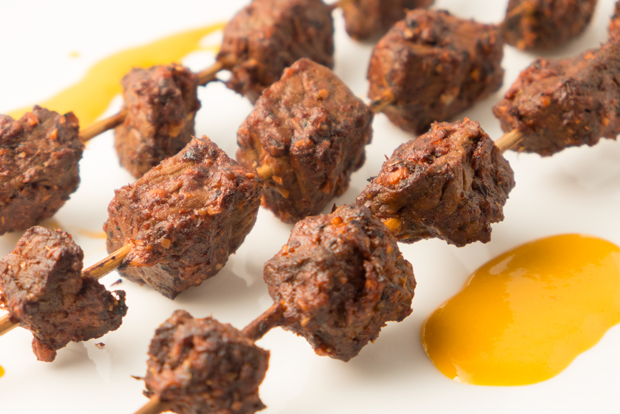Peruvian-style beef skewers (anticuchos) with aji amarillo sauce

Peruvian-style anticucho with aji amarillo sauce
I suspect that without the discovery of the New World the rest of the planet would still be subsisting on grass. From tomatoes to chile peppers and potatoes to chocolate, not to mention quinoa, South America, and the Andean region in particular, has had a disproportionately important and enriching influence on our diet. But it hasn’t been an entirely one-way street. The conquistadors who brought (stole?) these culinary riches back to Europe and disseminated them to Asia and elsewhere, also contributed a few things like garlic and beef that are now commonly used in that part of the world. And, more recently and perhaps less balefully, Peruvian cuisine has been influenced by repeated bouts of immigration from countries such as Japan, specifically Okinawa, and China, giving rise to distinctive cuisines known as nikkei and chifa, respectively. Indeed, Japanese of Peruvian descent are one of the most successful and influential ethnic groups in modern Peru (Fujumori, a former president of Peru, is the most (in)famous example of such a nikkeijin).
While it is a bit hard to pin down what exactly nikkei cuisine is, there’s no doubt that Peruvian-Japanese food has taken the world by storm. This is in no small thanks to chefs like Nobu Matsuhisa who, although not a nikkeijin himself, has taken what he learnt during his time cooking in Lima to North America and elsewhere. Today’s recipe for anticuchos–grilled meat skewers–combining soy sauce and yuzu with more traditional Peruvian ingredients is typical. (Chef Nobu’s original recipe is for steak. I’ve just repurposed it for skewers.) Anticuchos are typically made with organs such as heart, traditionally from animals like llama, although beef is far more common nowadays. Just as well since llamas are somewhat thin on the ground in Oxford! There isn’t much more to say about this recipe except that it is well worth the effort to track down the two chile peppers–ají panca and ají amarillo–called for. They’re not only essential to Peruvian food but also addictively good.
Peruvian-style beef skewers (anticuchos) with aji amarillo sauce
Yield: 2 servings
Prep Time: 15 min (plus 2 hours for marinating)
Cook Time: 15 min
Total Time: 2 hours 30 min
Ingredients:
- 250 g hanger or beef tenderloin steak cut into 2 cm cubes
Marinade:
- 1 Tbsp ají panca paste
- 2 Tbsp sake
- 1 Tbsp rice vinegar
- 2 garlic cloves, finely minced
- ½ tsp ground cumin
- ½ tsp dried oregano
- salt and freshly ground pepper to taste
- 1½ Tbsp neutral oil like canola, plus more for grilling
Dipping sauce:
- 1 Tbsp ají amarillo paste
- 1 tsp soy sauce
- 2 tsp yuzu juice
Directions:
- In a bowl mix the marinade ingredients together. Taste to adjust seasonings and pour over the meat. Mix well and refrigerate for at least a couple of hours. Remove from the fridge 30 minutes before cooking.
- If using bamboo skewers soak them in cold water for a few hours.
- In another small bowl mix together the dipping sauce ingredients and set aside.
- When ready to cook, thread 4-5 pieces of meat onto each skewer and brush lightly with oil. Heat a grill pan over high heat and cook the skewers, 2-3 at a time, for about 8-10 mins until beginning to char a bit. Turn them over every once in a while to cook evenly. Alternatively, place the skewers on a broiler pan set over a foil-lined baking pan to catch drippings. Grill in the oven under the broiler, turning every once in a while.
Serve with the dipping sauce.
Adapted from a recipe by Nobu Matsuhisa (link)
